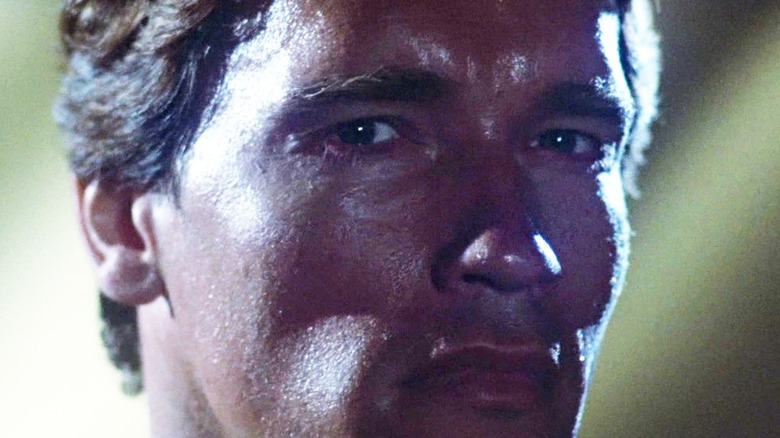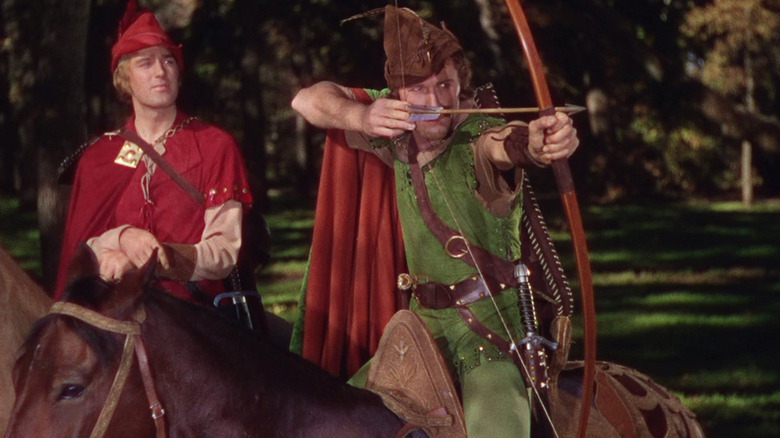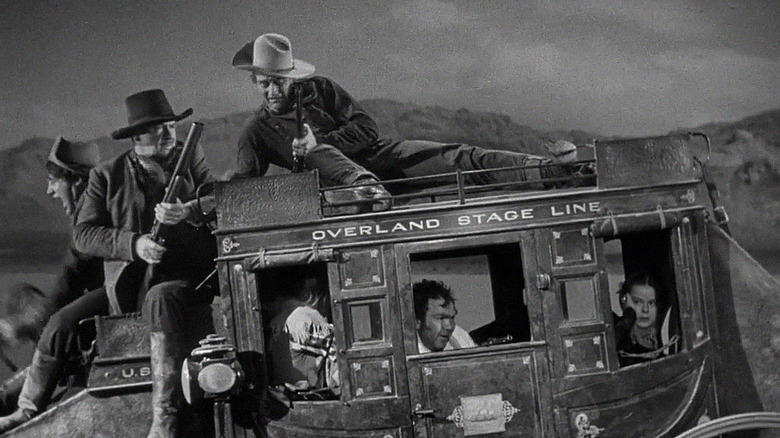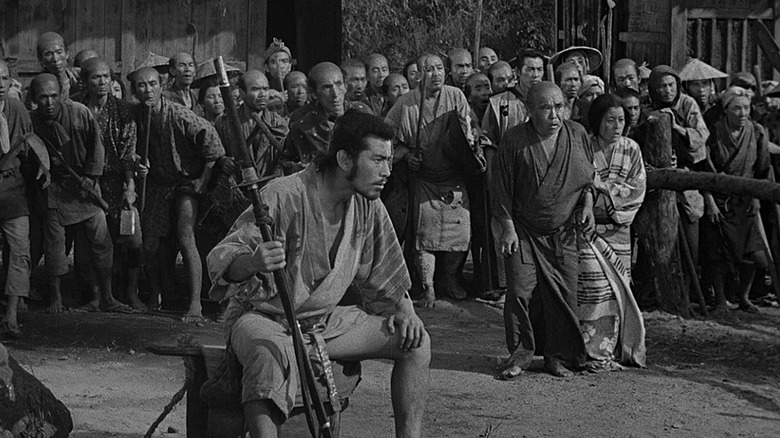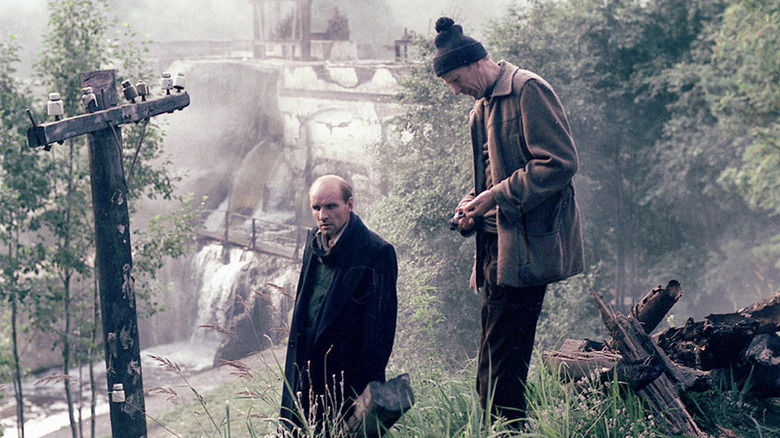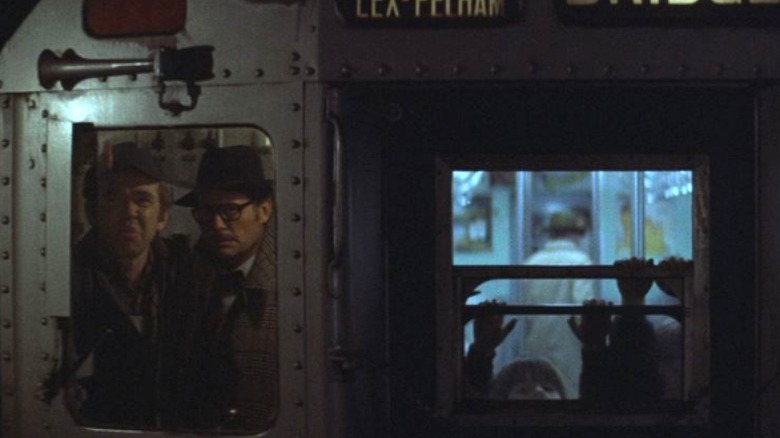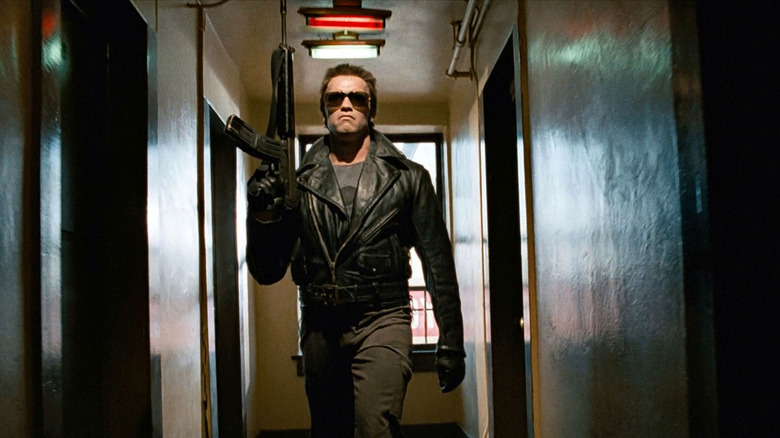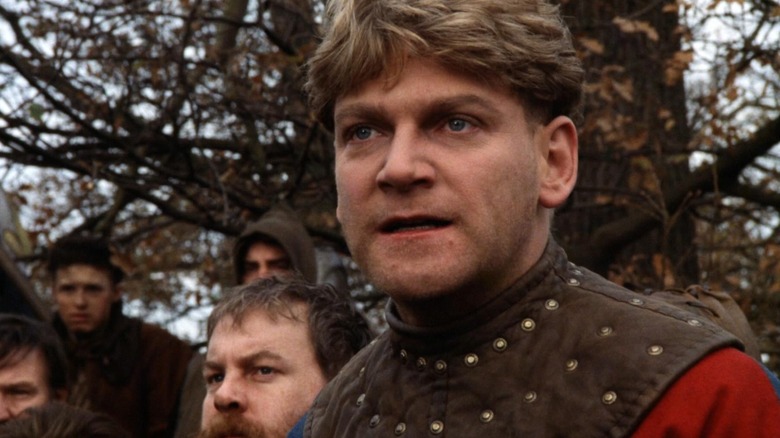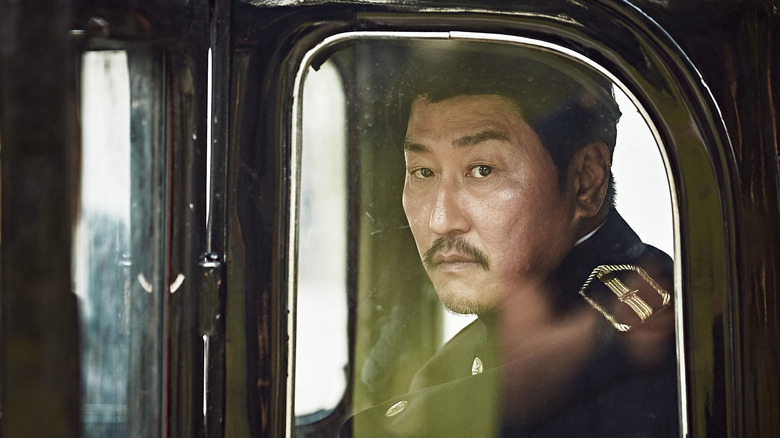These Are The Only Action Movies With Perfect Rotten Tomatoes Scores
In today's movie marketplace, action flicks don't necessarily get (or even aim for) much critical acclaim. In fact, they often account for some of the worst-reviewed films in any given year. But the genre that includes everything from shoot-em-up westerns to futuristic space conflicts has been part of Hollywood's repertoire since the beginning, and the best action films have made for some of cinema history's showiest standouts.
With their big stars and even bigger budgets, action and adventure movies are a high risk, high reward proposition. This category has the potential for broad appeal and frequently relies on familiar intellectual property for its subject matter, which means millions upon millions of viewers are either really happy or really let down by the final product. Many much-hyped action movies miss the mark, but occasionally, projects like "Black Panther" and "Mad Max: Fury Road" exceed expectations. However, with as many moving pieces as go into the production of an action movie, it's nearly impossible to please everyone.
Only nine action films have managed to maintain Rotten Tomatoes scores of a perfect 100%. Since the website aggregates reviews, older movies — especially those that were released prior to the internet's ubiquity — have an advantage. Still, this impressive list of nine spans nine decades and just about every action subgenre.
The Adventures of Robin Hood
To whatever extent the legend of Sir Robin of Locksley is true, his legacy is enormous. The character has spawned dozens of movies and TV shows on his way to becoming the archetype for countless other stories about do-gooder rogues. There's Disney's anthropomorphic version and Mel Brooks' comedic one. Kevin Costner, Russell Crowe, and Taron Egerton have played him, too. However, the pinnacle of these many adaptations is 1938's "The Adventures of Robin Hood" starring Errol Flynn as Robin Hood and Olivia de Havilland as Maid Marian.
1922's "Douglas Fairbanks in Robin Hood" had already been a massive hit when Warner Bros. began production on their film. It would turn out to be one of their most troubled and expensive shoots, but it would all be worth it in the end, per Den of Geeks. "The Adventures of Robin Hood" was meant to feature black and white and star James Cagney, and the original script was written in the mannered language of medieval England. More than three years and $2 million later, it was released in Technicolor, with Flynn speaking in a contemporary vernacular. These proved to be fortuitous decisions.
This version of Robin Hood was ultimately a hit with audiences, and "The Adventures of Robin Hood" went on to be nominated for four Academy Awards, including best picture, winning three. Critics agreed that Flynn made for an ideal swashbuckling Robin and that the film itself was a revelation beyond reproach, with Variety describing the film as "cinematic pageantry at its best."
Stagecoach
John Ford and John Wayne are two icons of the American western, and 1939's "Stagecoach" is the high watermark of their collaborative friendship. However, film critic Emanuel Levy explains that it almost didn't happen that way. Neither the Duke nor the Western itself may have taken off in the popular culture if it had not been for the success of this seminal film.
Ford read a short story called "The Stage to Lordsburg" in a magazine, acquired the rights, and set about expanding it into a feature. The subsequent script by Dudley Nichols was an ensemble piece about nine strangers on a dangerous trek through American Indian territory. Ford wanted a then-unknown John Wayne to star as Ringo Kidd, the central character. Wayne was a fixture of "poverty row" movies but had only appeared in one professional production, which had promptly bombed. The studios wanted Gary Cooper, but Ford was insistent. After some budget compromises, he got to make the movie he wanted to make.
The result was a highly entertaining, expertly crafted, multi-layered film that elevated the Western from B movies to a true art form. "Stagecoach" drew praise for its cinematography (it was the first of Ford's Westerns to shoot on location in Monument Valley), action scenes (including one thrilling chase sequence that set the standard for all that would follow), score, and capable performances. "Stagecoach" was nominated for seven Oscars and won three and is also preserved in the National Film Registry for its historical and cultural relevance — though it should be noted that its depiction of the Apache is now considered offensive.
The Treasure of the Sierra Madre
The 1948 film "The Treasure of the Sierra Madre" features Hollywood legends John Huston and Humphrey Bogart doing arguably their career-best work. This classic adventure, based on B. Traven's 1927 novel of the same name, tells the story of two long-suffering drifters — Dobbs and Curtain (Bogart and Tim Holt) — who join up with an old prospector (Walter Huston, the director's father) to hunt for gold in the hills of Mexico.
Huston was fresh off of his enormously successful directorial debut, "The Maltese Falcon," and Bogart was Warner Bros. most recognizable star. Expectations were high, but "The Treasure of the Sierra Madre" delivered, though not exactly what audiences were expecting. The film was unusually dark and challenging for its time. Bogart's protagonist is a wholly unlikeable character, there's no love interest, and the script kept running into problems with the Hays Code. However, critics and audiences alike were captivated by the cinematic storytelling and compelled by what it had to say about masculinity and greed.
"The Treasure of the Sierra Madre" continues to reverberate around the industry today. Spike Lee's "Da 5 Bloods" was inspired by it, and Daniel Day-Lewis based his performance in "There Will Be Blood" on Bogart's portrayal of an anti-hero. It appears on several lists that rank the top films of all time and is included in the National Film Registry. The film was nominated for four Academy Awards and ultimately won three (John Huston took home two trophies for his screenplay and directing and his father was named best supporting actor), but, controversially, Bogart was not recognized.
Seven Samurai
Akira Kurosawa is one of the most accomplished and revered directors in cinematic history with a filmography that includes multiple masterpieces like "Rashomon" and "Ran." Hollywood Insider observes that this Japanese auteur often pulled from the plots, characters, and themes of Shakespeare, and his work has, in turn, influenced international filmmaking. The 1954 film "Seven Samurai" is widely regarded as his greatest achievement. The film has been remade and referenced many times, and its fingerprints can be found everywhere, from "The Magnificent Seven" to "Star Wars" to "A Bug's Life." The template "Seven Samurai" introduced remains a Rosetta Stone of sorts for westerns, sci-fi films, and superhero movies especially.
Dennis Harvey points out in 48 Hills that Kurosawa's film became the "model for future action movies" with its "assembling the team of fighters narrative." The film takes place in 1500s feudal Japan as a poor village tries to recruit rōnin (samurai without masters) to defend their land against marauders who are planning to pillage their harvest in the coming year. There are character introductions, training sequences, tense duels, and epic final battles. While some of these scenes might feel cliché today, that's only because "Seven Samurai" did them so brilliantly and made them hallmarks of the genre.
Kurosawa was also a painter and was particularly adept at shot composition. As such, critics gave it high marks for its stunning visuals, alongside its engrossing, emotional story. In addition to its perfect Rotten Tomatoes score, "Seven Samurai" has been ranked among the best films of all time by many publications and critics.
Stalker
If "Seven Samurai" became the model for superhero movies, this 1979 Soviet film by Andrei Tarkovsky set the tone for the many existential, slightly sci-fi, dystopian thrillers that came after it. "Stalker" takes place in an unknown country, in an unknown time — though it's hinted it's the near future after a nuclear fallout. Audiences meet a man known only as the Stalker who claims to be able to lead people through the Zone to a mysterious Room where their deepest wishes will be fulfilled. Strictly speaking, none of this is legal, and the Zone is clearly hazardous, as the Stalker's child appears to have suffered disfigurement from the environment in which the family lives. The Stalker's wife disapproves of the whole enterprise.
Two men become his clients. There's a Writer in search of ideas for his books and a Professor who hopes to win a Nobel prize for scientific discovery. Their journey through The Zone is arduous enough, but things reach a fever pitch when they reach The Room and begin to question what they desire.
Tarkovsky — the Russian director of "Mirror" and the original "Solaris" — was ahead of his time in experimenting with film as a medium to explore complex psychological and spiritual themes. As noted by Salon, people (including the Soviet State Committee for Cinematography) didn't get "Stalker" at first, but once it became apparent that Tarkovsky had made something that would change the state of the art, the film received a much-deserved reevaluation. Now "Stalker" is universally admired for its haunting imagery and its profound commentary on the nature of human consciousness and belief.
The Taking of Pelham One Two Three
In the 1970s, crime thrillers set in New York City were all the rage. Though films like "Taxi Driver" and "Dog Day Afternoon" have become celebrated examples of the era, place, and genre, only 1974's "The Taking of Pelham One Two Three" has a Rotten Tomatoes score of 100% and the fawning reviews to back it up. Critics appreciated the film's fast pace, wisecracking dialogue, inventive score, and the way it balanced its pressure-cooker action plot with enough time and space for the audience to get to know and care about its well-drawn characters.
Based on a 1973 crime novel of the same name, "The Taking of Pelham One Two Three" stars Robert Shaw as Mr. Blue, the man who — along with Mr. Green, Mr. Gray, and Mr. Brown — takes a New York City subway car full of 18 people hostage. He threatens to shoot one person a minute if the city doesn't pay him a ransom of $1 million within the hour. Walter Matthau is Lieutenant Garber, the Transit Police Officer tasked with stopping him. The film also features Héctor Elizondo and Jerry Stiller.
Like other films on this list that proved to be critically and commercially successful, "The Taking of Pelham One Two Three" has since been remade twice. A TV version starring Edward James Olmos and Vincent D'Onofrio aired on ABC, and a theatrical version starring Denzel Washington and John Travolta debuted to less than stellar reviews. It seems nothing can recapture the effortless cool of the original.
The Terminator
The 1984 film "The Terminator" is the movie that gave James Cameron his blank check to make blockbusters like "Titanic" and "Avatar" on an enormous scale, and the story of its production is almost as epic as the film itself. Cameron had only worked as a director on one movie before "The Terminator" (1982's "Piranha 2: The Spawning," from which he'd been fired), so he didn't have much clout in the industry. What he did have was a sellable idea for a film about a cyborg assassin who would be sent to earth to relentlessly hunt down and kill the mother of the would-be future resistance leader. With a relatively meager $6 million budget, Cameron set about casting what everyone (even the studio and actors) assumed was a B-movie.
The year's most famous faces were considered for the two lead male roles, including Mel Gibson, Sting, O.J. Simpson, and Bruce Springsteen. Arnold Schwarzenegger was initially meant to audition for Kyle Reese, but Cameron sensed that his presence and accent were better suited to play the villain. Using Arnold as the Terminator turned out to be a stroke of brilliance, as his performance was instantly iconic.
Instead of just another B-movie, "The Terminator" ended up in the Library of Congress's National Film Registry and is included in several American Film Institute rankings. Critics praised the film for combining the best elements of sci-fi, horror, and action-adventure. "The Terminator" was so successful, it generated its own franchise and continues to influence the entertainment industry — especially movies about time travel and technology — to this day.
Henry V
Kenneth Branagh's extremely prolific and wide-ranging career as an actor, writer, and director has taken him from Hogwarts to Asgard and back home to Belfast. But before he was busy making regrettable adaptations of "Artemis Fowl" or "Death on the Nile," he was best known for adapting and starring in the works of William Shakespeare, with varying degrees of success. Branagh shepherded the screen versions of "Hamlet," "Much Ado About Nothing," "As You Like It," and "Love's Labour's Lost." However, according to critics, one film stands head and shoulders above the rest.
1989's "Henry V" is a faithful but accessible translation of Shakespeare's historical drama of the same name, and it marks Branagh's first time being both in front of and behind the camera (he was nominated for best actor and best director at the Academy Awards that year). In "Henry V" the young King is convinced that he has a claim to the French throne and is easily persuaded to invade after the Dauphin insults him. His inner circle and his army enjoy victories and endure setbacks until things come to a head at the Battle of Agincourt. Meanwhile, the princess to which Henry was formerly betrothed, Katharine (Emma Thompson, who was married to Branagh at the time), waits with the enemy to see what will happen. The film also features Robbie Coltrane, Derek Jacobi, Judi Dench, and a young Christian Bale.
Sir Laurence Olivier had already directed and starred in his own well-received version of "Henry V" in 1944, to which many critics, such as Robert Ebert, were quick to draw comparisons. However, Branagh's version stands on its own as a gritty, hotblooded, and fully realized film.
The Age of Shadows
The 2016 film "The Age of Shadows" is the most recent addition to this list. It stars Korean actors who have, in the past few years, become better known to international audiences: Song Kang-ho (of "Parasite" fame) as well as Gong Yoo and Lee Byung-hun (both from "Squid Game"). Director Kim Jee-woon mashes several action-friendly genres together to create this wartime period piece noir spy thriller.
Set during the 1920s Japanese occupation of Korea, Song Kang-ho plays a Korean police captain who once aligned himself with the resistance but is currently working with his Japanese occupiers as he thinks doing so is in his best interest. He's initially willing to feed them information and follow their orders to hunt down resistance fighters in his community until one of them — his old friend from school — winds up dead. Sensing a change in his morals, the resistance leader and a shopkeeper-slash-smuggler plot to turn his allegiance to their cause. As is surprisingly frequently the case in action movies, much of the story takes place in the tense confines of a moving train.
Critics applauded "The Age of Shadows" for its richly textured recreation of the time period, twisty plot, artful brutality, and strong cast. Screen Daily notes that South Korea submitted it as its entry for best international feature at the Academy Awards in 2016, but it didn't make the final list of five nominees. However, "The Age of Shadows" draws on the conventions of the great action movies that came before it in a way that every film fan will recognize and enjoy.
